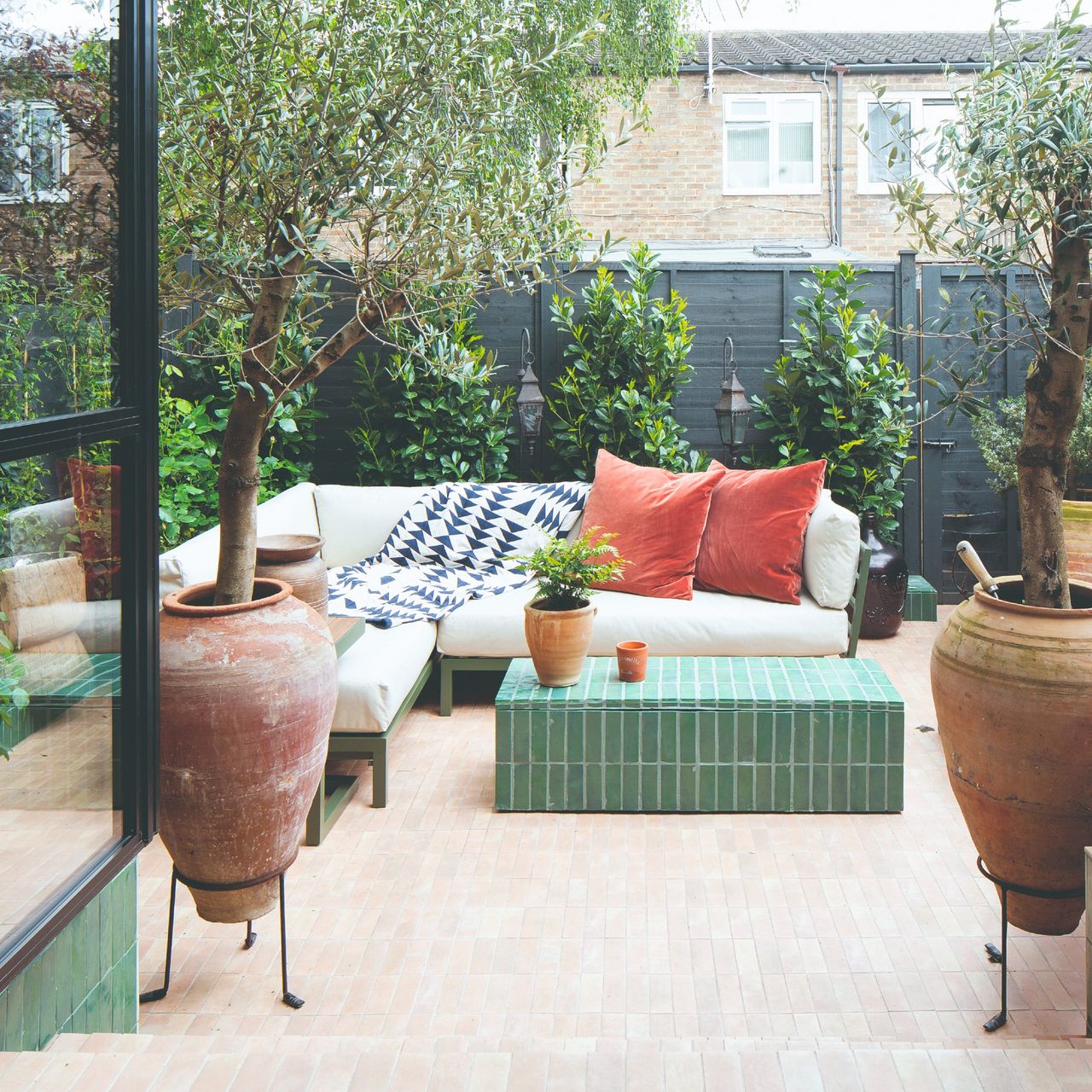
Gone are the days when our outdoor spaces were treated like an afterthought. These days, your garden, patio or even a balcony are an extension of your home and your style that invites you and your guests in and makes you want to stay – and that’s especially true when it comes to outdoor living room ideas.
From the most beneficial layouts to the best garden furniture, decor and styling to go for in your outdoor living space, this guide covers everything and more to make your space look and feel cosy, comfortable and elevated.
‘An outdoor living room should feel like a natural extension of your home,’ confirms Zara Fong, designer at King Living. ‘I believe comfort should always be the starting point. One of the biggest mistakes is treating the outdoor space like an afterthought. When the space is intentional and considered it becomes an extension of your interiors and a place you want to truly spend time in.’
Outdoor living room ideas
Your outdoor living room should be a balance between comfort and style – but form should never be prioritised over function. And yet, it’s one of the most common outdoor living room mistakes people make.
‘For outdoor living, you have to be comfortable first and foremost,’ says Bo Hellberg, CMO at Swedish outdoor furniture brand, Grythyttan Stålmöbler. ‘It’s where you’ll spend hours and days with friends and family throughout the summer. A mistake we often see is putting style ahead of practicality. Outdoor furniture needs to be sturdy and comfortable, not just pretty.’
1. Choose your outdoor sofa carefully
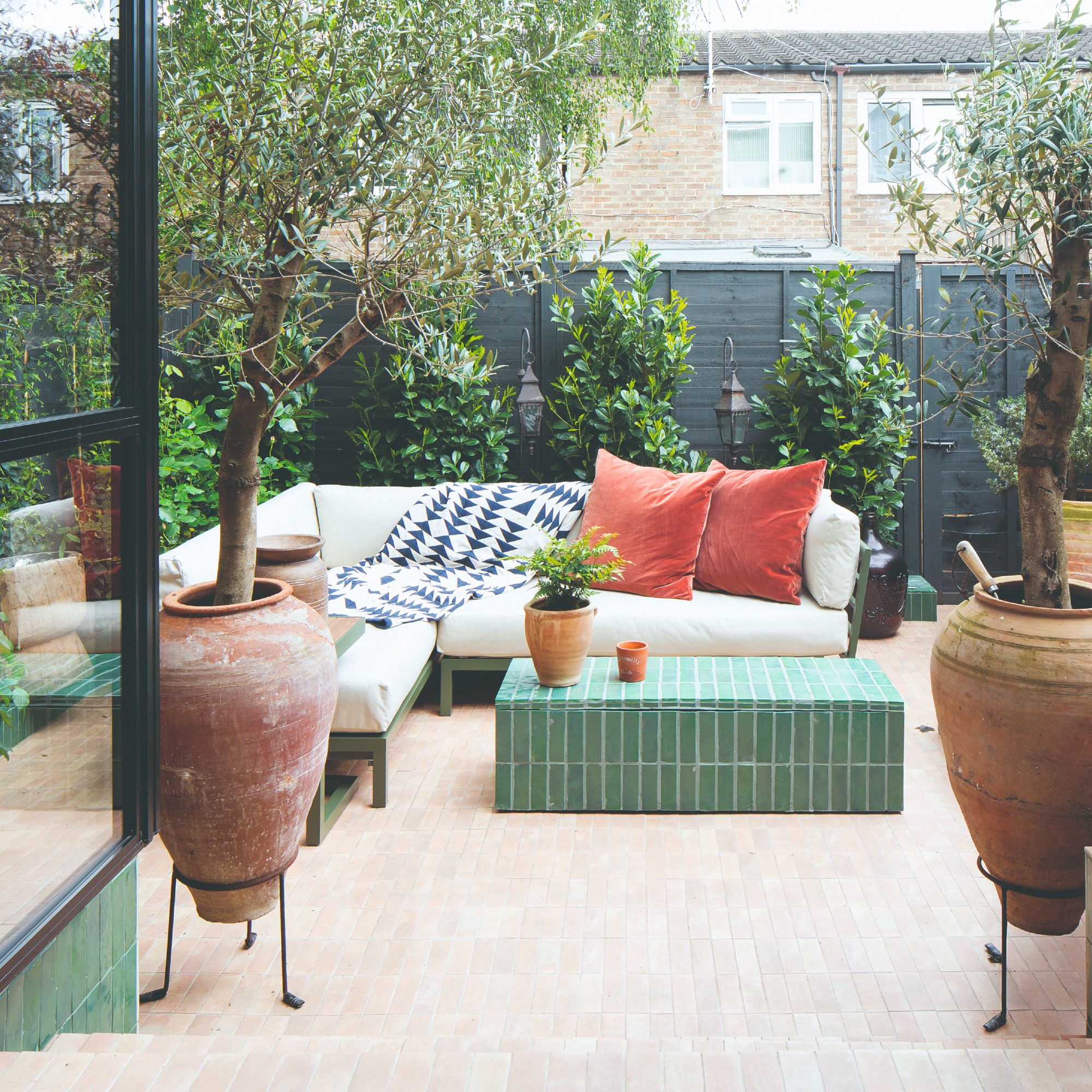
We’re true believers that garden furniture ideas should be held to the same high standards as the furniture you purchase for your interior. If anything, there are more boxes that outdoor furniture needs to tick. And just like your best sofa is the key piece in your indoor living room, your outdoor sofa will be the most important piece of furniture in your outdoor living space, too. So choose it carefully.
‘A sofa with deep, inviting seating is non-negotiable. If it’s not comfortable, no one lingers. When it comes to fabrics, always make sure it’s engineered for the outdoors with performance fabrics that resist fading and moisture, while still feeling and looking luxurious. Let the environment do the heavy lifting, and choose a sofa that complements it,’ Zara at King Living says.
Mike Durbridge, CEO of Andrew Martin, continues about some of the most durable types of outdoor furniture and outdoor sofas you can invest in, ‘Weather resistance plays a significant role in prolonging the life of your furniture. Rust-proof frames, such as powder-coated aluminium, ensure durability in a variety of climates. The powder-coating process involves applying a protective layer that bonds to the metal, creating a barrier against moisture and oxidation. This prevents rust from forming, even in humid or coastal environments where exposure to salt air can accelerate corrosion. Outdoor fabrics must be quick-drying, stain-resistant, and easy to clean to ensure they maintain both their appearance and functionality over time.’
2. Think about the purpose of the space
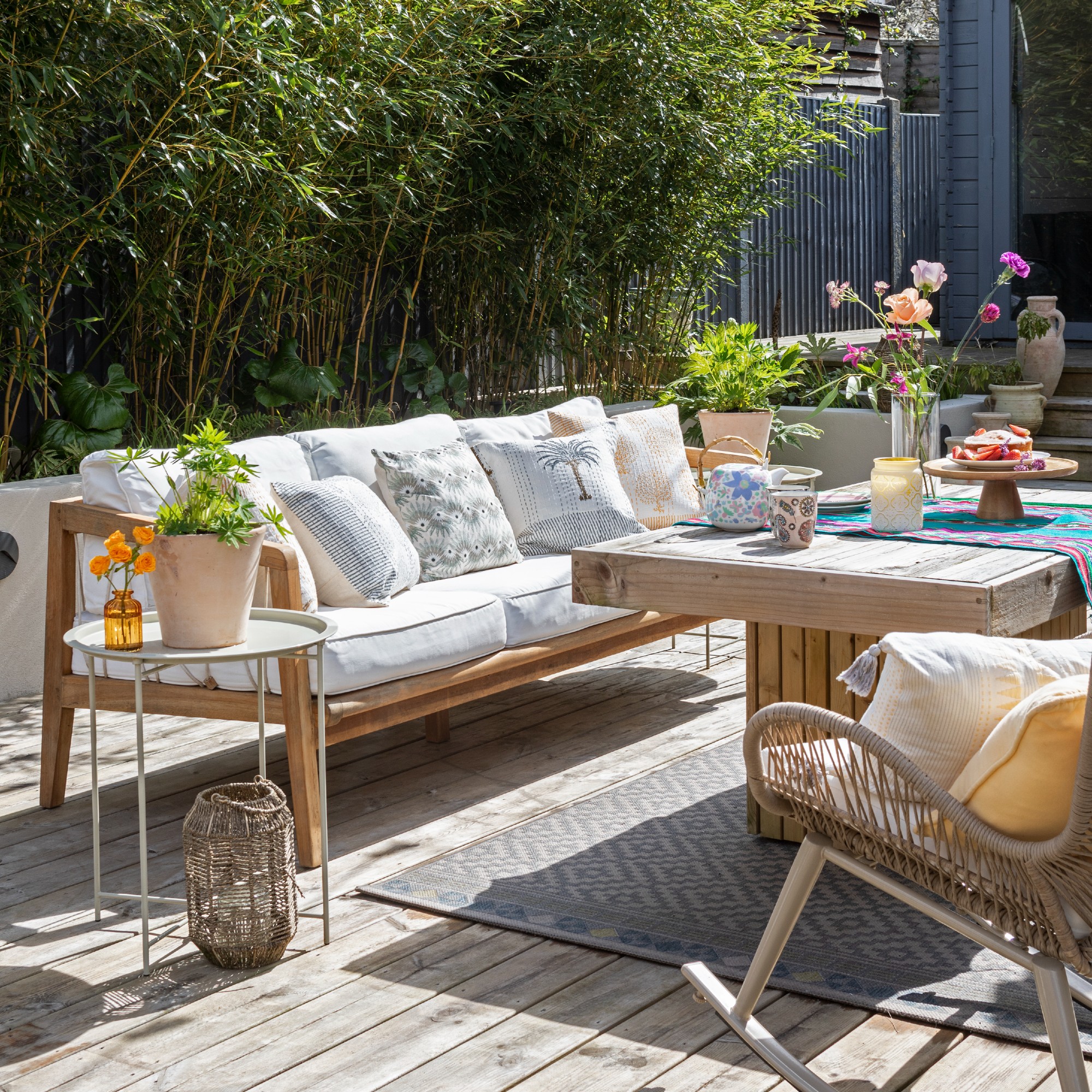
The best way to lay out and furnish your outdoor living room will be largely down to how you tend to - or look to - utilise the space.
‘Think about how you want to feel when you step into the space. Do you want to unwind with a glass of wine? Entertain friends? Curl up with a book? Let that emotional cue shape your layout and styling choices,’ Zara at King Living says.
Alex Bridgman, CEO of Bridgman, agrees, ‘Don't ignore your needs. Establish from the very beginning what you need from your outdoor furniture. A simple way to achieve this is by making a list of all of the activities you'd like to do in the space before buying your garden furniture. For example: if you'd like to use your patio to relax with your loved ones on a warm evening, opt for a modular sofa set that you can configure to suit your family. If you'd prefer to host intimate al fresco dinner parties, barbecues, brunches and so on, choose a small dining set.’
3. Go for a modular outdoor sofa
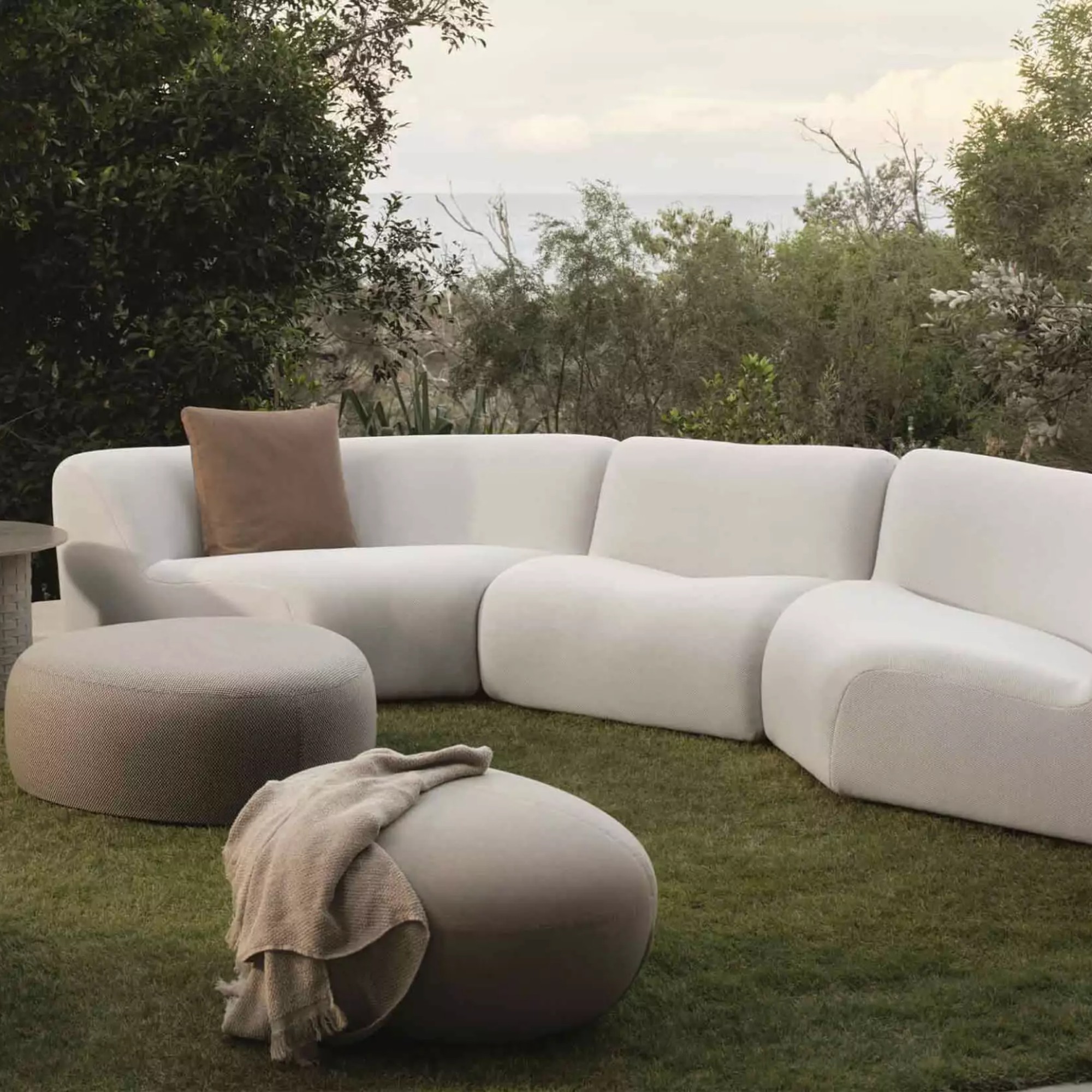
A modular sofa is one of the best types of living room seating you can invest in as they are flexible and versatile. And the same goes for your outdoor living space and outdoor sofas.
‘I always suggest choosing modular styles because they offer flexibility as your space or needs evolve,’ Zara at King Living recommends.
Alex at Bridgman continues, ‘Modular garden furniture is one of the best things you can buy for your garden, especially if you’re regularly entertaining guests or hosting family. Easy to manoeuvre and maintain, one of the benefits of going modular is that you can adapt and reconfigure your furniture set to suit the number of guests. Modular sofas are ideal for homeowners looking to bring the comfort and appeal of the living room into the outdoors – creating an outdoor living room space that’s perfect for lounging in the sunshine or relaxing with a good book.’
4. Incorporate enough tabletop space
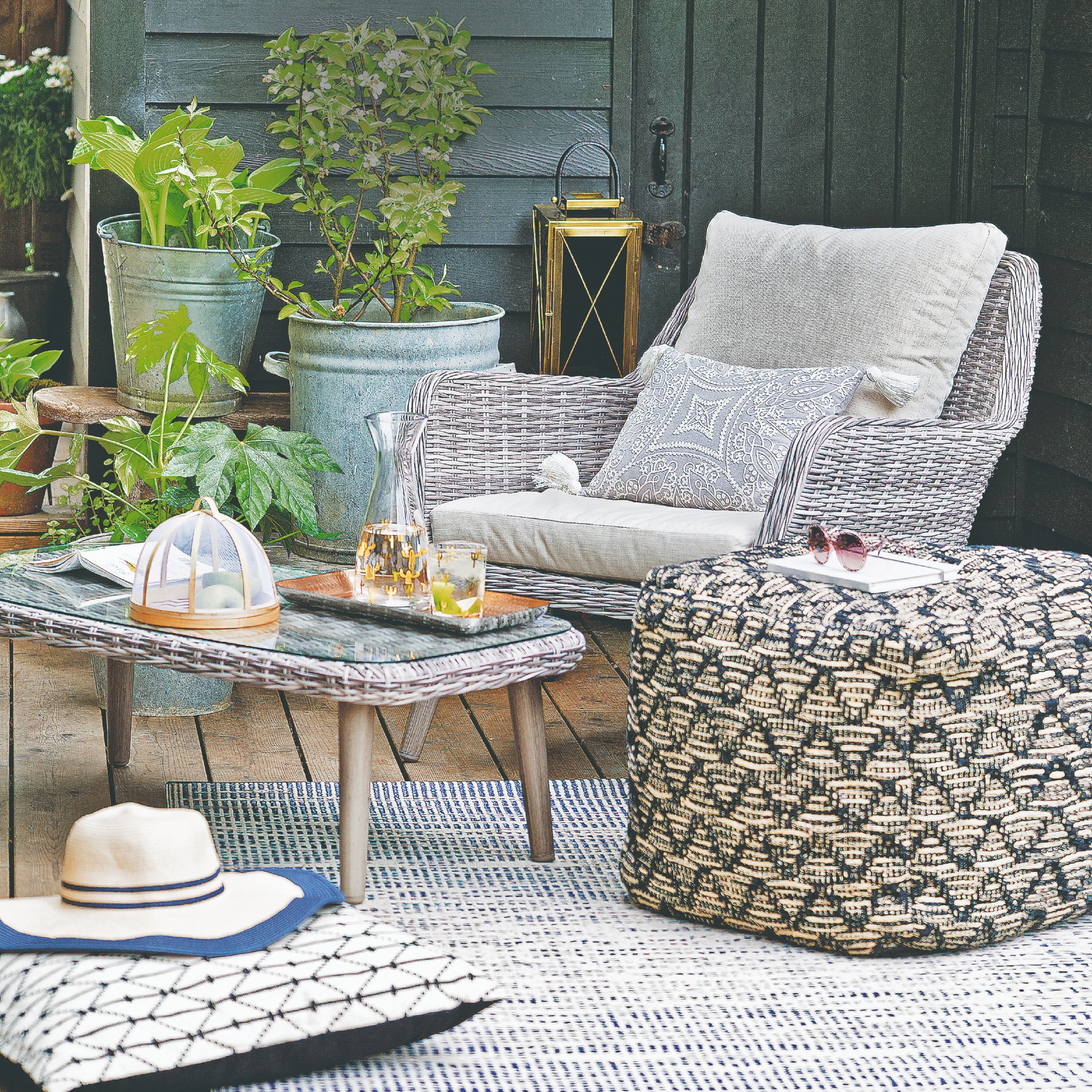
When it comes to your outdoor living room furniture, all you really need is some form of comfortable seating - ideally an outdoor sofa - and then a table (or tables) to rest your drinks and refreshments on top of. You can go for a couple of side tables joined by a coffee table in the middle to make sure there’s enough surface space. But if space doesn’t allow, you can also eliminate either the coffee table or the side tables and just go with one or the other.
‘Choosing your coffee table shape is completely dependent on the space it sits in and the furniture it sits beside. In an outdoor space, your coffee table will usually sit at the centre. If you have a straight corner set, a square or rectangular coffee table is your best choice. If you have a curved modular set on the other hand, then a round table is a must. The same can be said for living rooms. If you have a sofa with an armchair at 90 degrees to it, then a square table will best fit the space by mirroring the arrangement of your furniture. However, if you've opted to position your armchair at more of an angle, then a round table could look better as it will open up your space a little more,’ Alex at Bridgman says.
5. Take inspiration from Scandi style
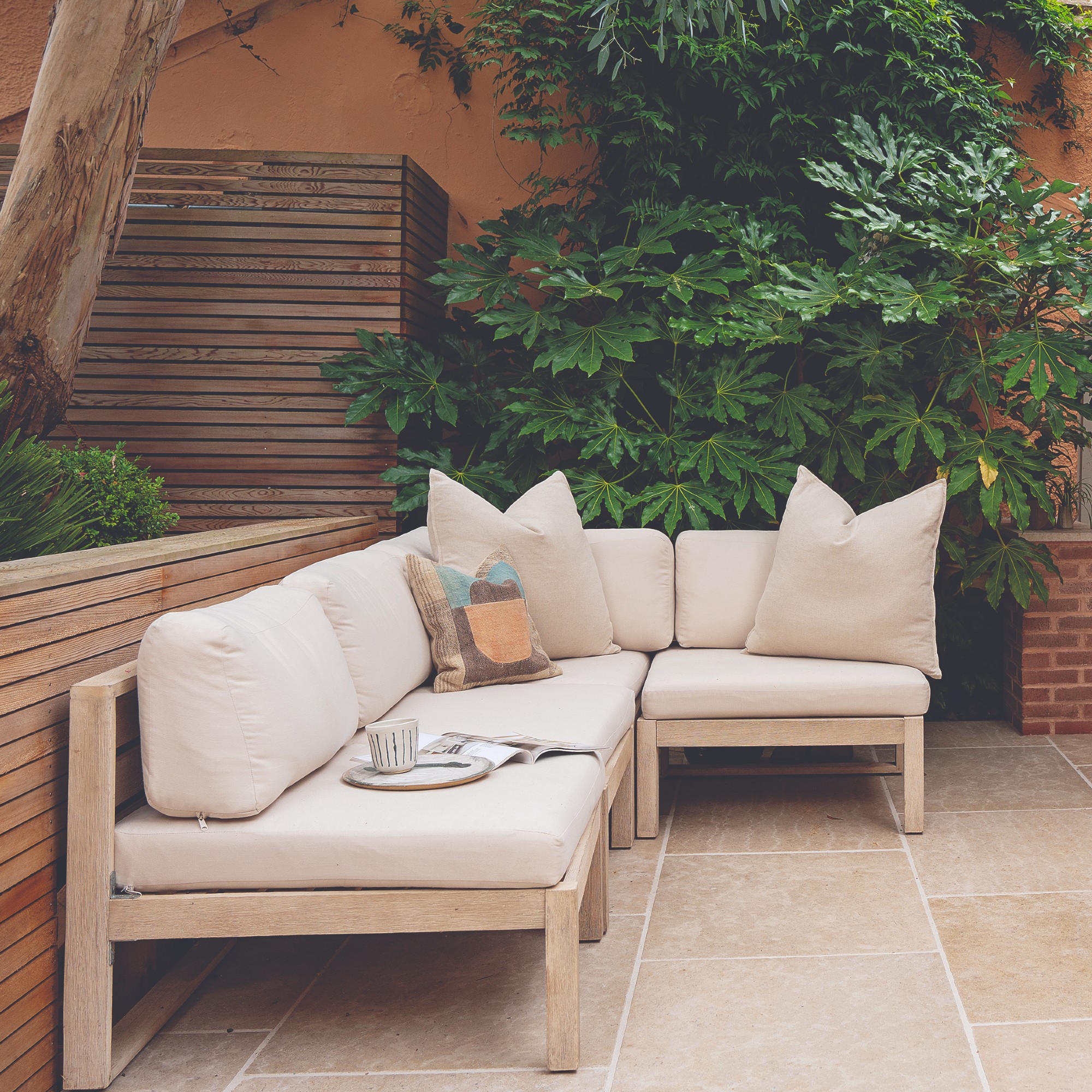
Scandinavian design has risen in popularity over recent years, and it's definitely here to stay - so why not bring it into your outdoor living room?
The Scandi trend of hygge is all about bringing a cosy aura into our living spaces in the winter months, and the summer equivalent is the idea of a 'sitooterie'. This is defined as an outdoor living zone that feels tranquil, so you can immerse yourself in nature in the comfort of your own home.
Emily Simmons, creative director at Ruggable, says 'Scandinavian design is known for its minimalist, simple and functional approach. To incorporate this style into your sitooterie, opt for light natural wood furniture and neutral tones. Then you can incorporate understated accessories such as simple planters, woven patterned rugs, and soft cushions in muted colours.'
Using rattan in an outdoor space is great for creating an earthy feel that is also right on trend. It's durable too, so you won't need to worry about it being ruined by the elements.
'Rattan's extremely durable construction makes it highly resistant to temperature changes and rusting, making it ideal for both indoor and outdoor use. Its versatility allows it to tie into existing décor while maintaining its unique character seamlessly,' says Cleo Allen, design account director at Andrew Henry Interiors.
'It can be styled in endless ways to fit whatever vibe your space has - whether you prefer a classic relaxed feel or are more modern and edgy in your tastes, rattan will provide the perfect touch.'
6. Pick pallets
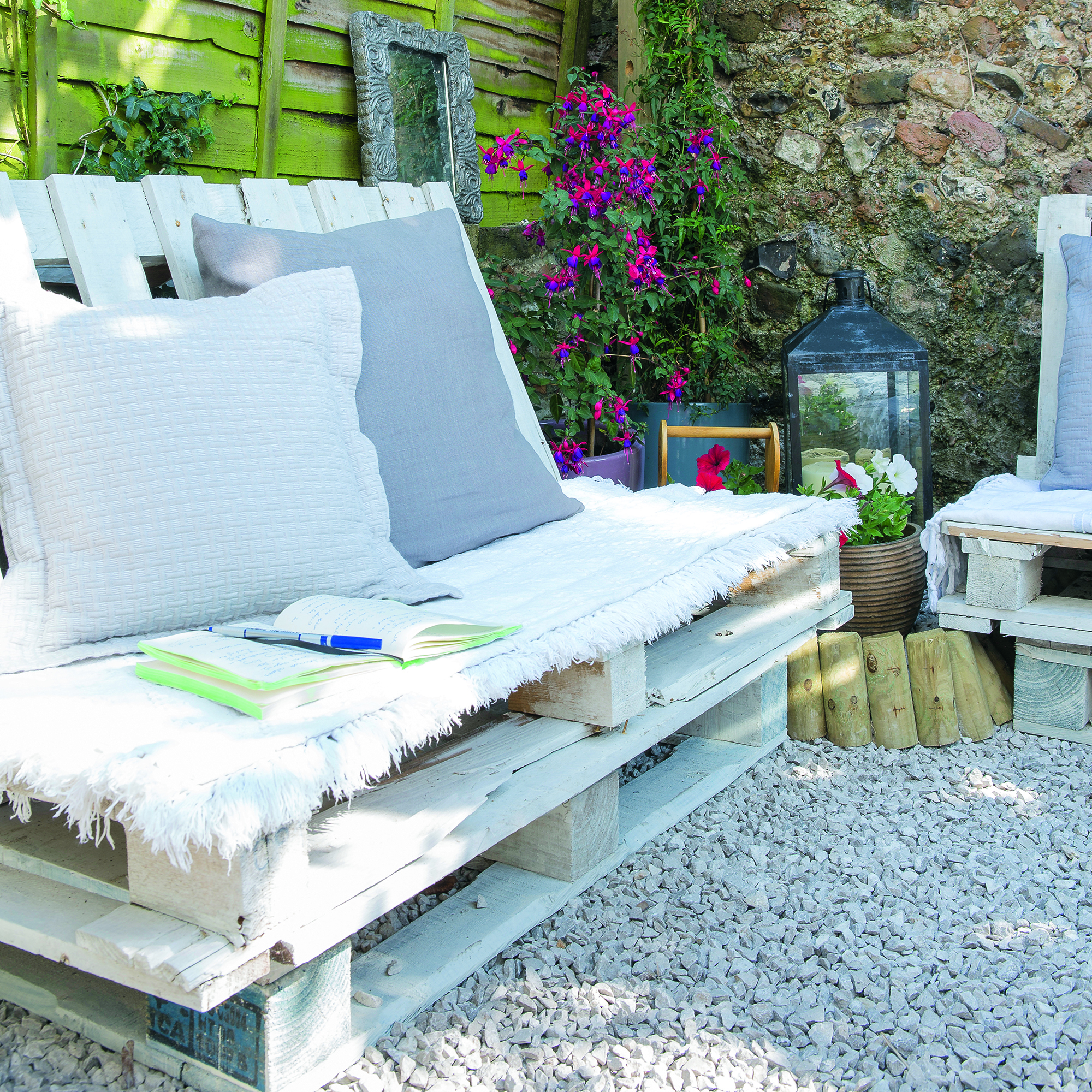
If you're looking for a laidback outdoor living room space, then pallets could be your answer. They're easy to get hold of, and you can paint them in a colour of your choosing to customise the look to your scheme, whether that's opting for an Ibiza-inspired white look or keeping it down-to-earth by sticking to the original wood.
Opting for pallet ideas for your garden will also be a functional seating choice You can easily move them around in different configurations, or even store them in a shed or garage when the weather takes a turn.
7. Reflect the sun
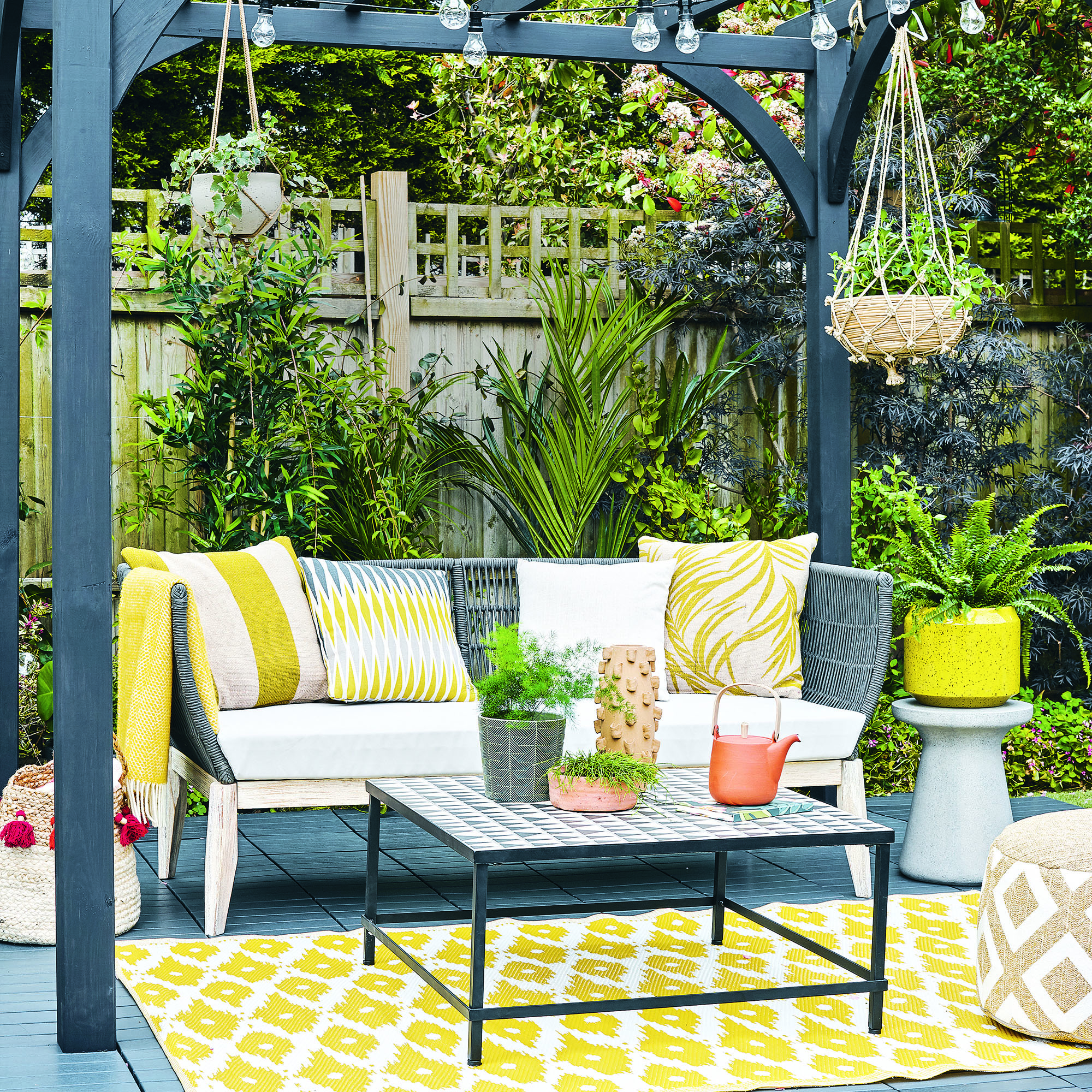
Choosing a colour scheme for your outdoor living room is just as important as picking the decor for within your home. It can be the marker for giving your garden personality, and you can also tie it into your interiors to create an indoor-outdoor look that effortlessly flows.
Paul Garland, lead designer at Andrew Henry Interiors, says 'Vibrant combinations of peach pink, fiesta and daylily create a juicy palette, oozing the flavour of sweet fruit. This sun-loving colour wheel elicits a sense of happiness, reminiscent of joyful days spent by the pool, whilst brighter shades are softened with mellow yellow and bisque. Introduce lighter woods into outdoor living/dining areas as well as touches of greenery to mimic an alfresco vibe.'
A yellow scheme is the perfect sunny solution for bringing the heat to your outdoor living space, even when the clouds appear. Bursts of colour are also easy to incorporate through outdoor cushions and outdoor rugs, so you can find affordable options to complete your furniture.
8. Embrace nature
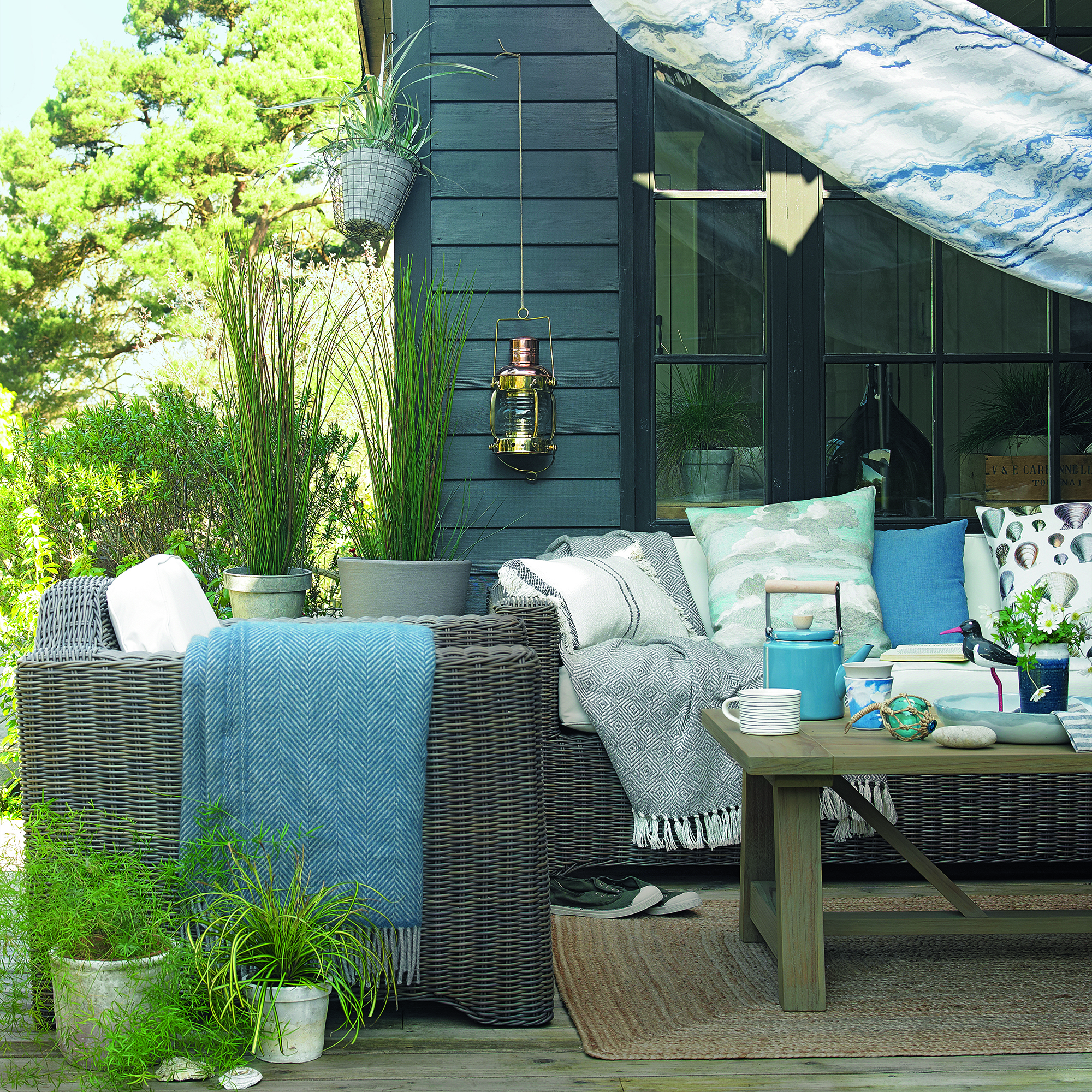
Embracing nature seems like an obvious choice for a garden, but being intentional about the flora you choose around your living zone will greatly impact how you use it. This is especially true if your outdoor seating is positioned on a patio or decking, as adding varied plants will make the whole garden feel like a curated oasis.
'If space is limited, I would utilise vertical space, such as incorporating hanging planters, trellises, or wall-mounted herb gardens to add a touch of nature without compromising on precious floor space,' says interior designer Rudolph Diesel.
'These vertical elements also create a sense of depth and visual interest, taking your outdoor space from just a cosy seating area to a luxurious haven.'
Easy climbing plant ideas will be low maintenance while creating a striking look, leaving you plenty of time to enjoy the fruits of your labour.
9. Choose strategic seating
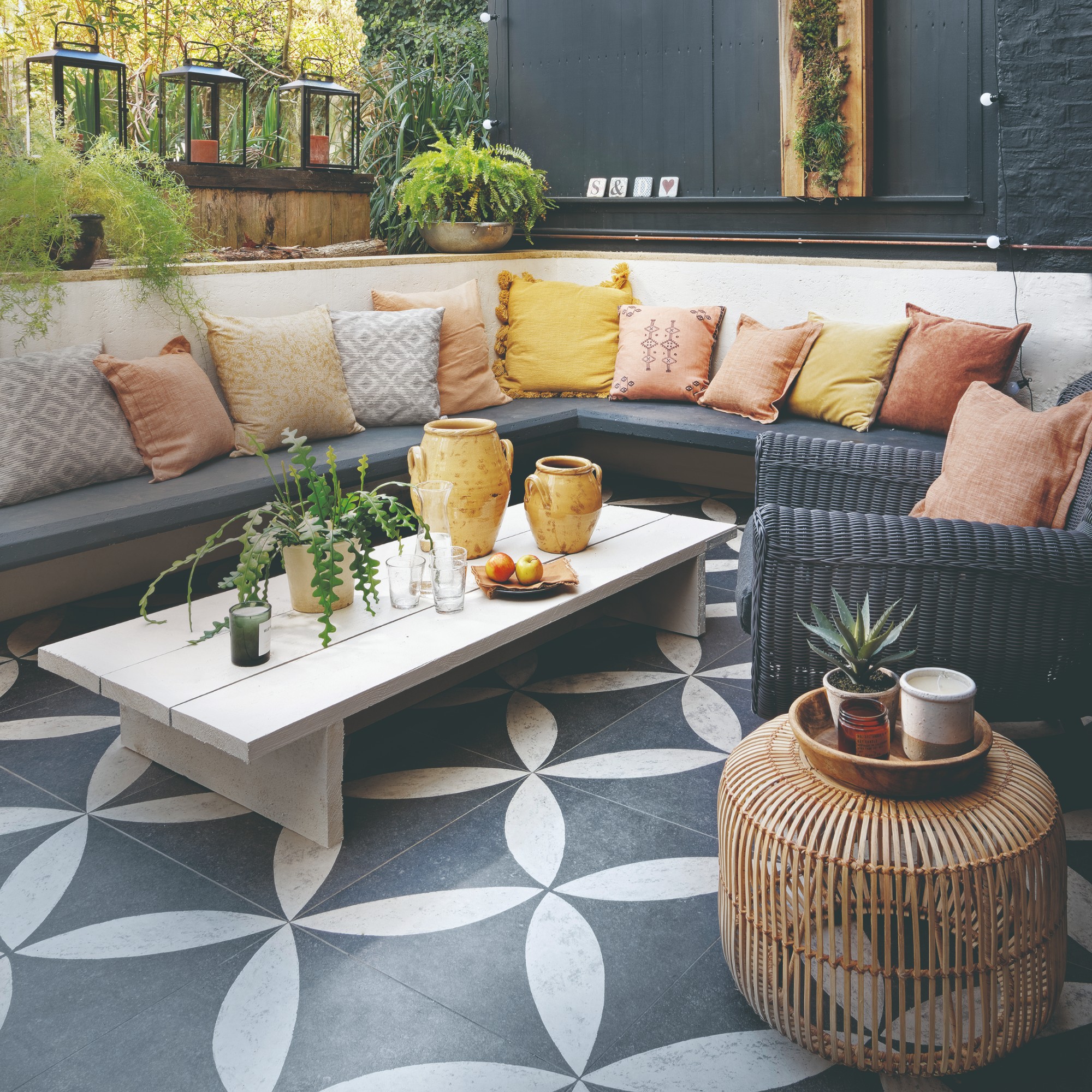
Creating a flexible seating arrangement in your garden will hugely impact how you use the space, and how often you sit outside. Big outdoor sofas are great for large gardens, but they can take longer to set up if you have many cushions stored away. By opting for separate seating options, you can quickly get your outdoor living area arranged if you want an impromptu breakfast outside, and it's easy to pull out of storage.
Rudolph recommends choosing 'compact seating options that can be easily tucked away when not in use such as during the winter or days where you want more floor space. Bistro sets, folding chairs or stools are great space-saving choices, but I would also consider incorporating built-in seating like benches along the perimeter of your outdoor area.
This not only maximises seating but also saves space and creates a defined ‘zone’ where you can chill out, helping break your garden up and make it feel less crowded.'
10. Don't forget to accessorise
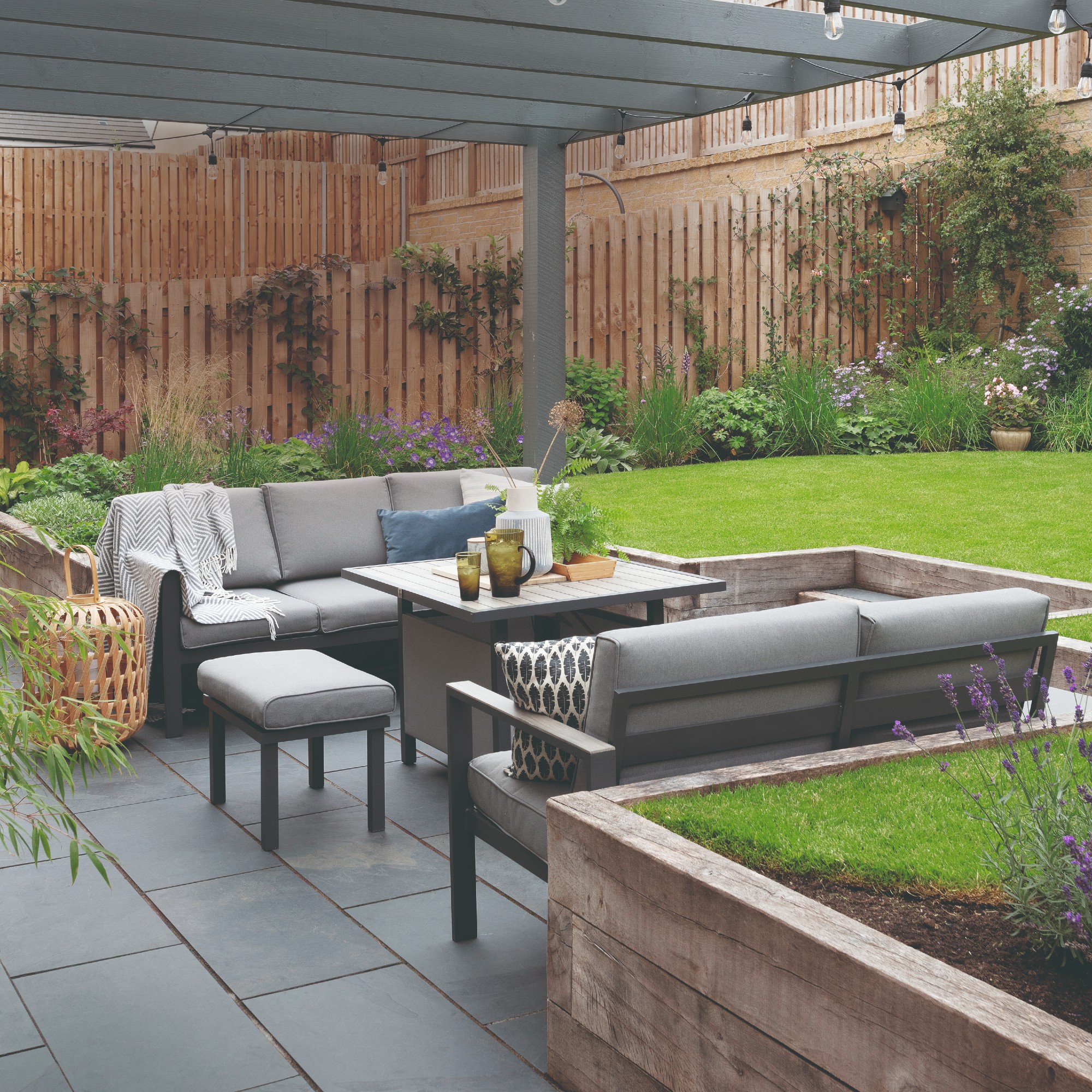
Your living room wouldn't be complete without the perfect accessories, so why would your outdoor living room be any different?
Outdoor furniture is great for making a garden feel ready for entertaining, but it can sometimes feel lacklustre without the addition of decor. You can easily decorate by placing objects around seating areas or making use of brickwork with some wall decor ideas.
'You can add more artistic and interesting things to give an outdoor space a contemporary feel. Think outdoor mirrors, vases, clocks, and hanging artwork or sculptures. All of these create a feeling that the garden space is decorated in the same way you’d decorate your lounge,' says Emma Cottrel, marketing manager at BoConcept.
'The key to creating an outdoor living room is cultivating a comfortable space that you can relax in. It’s also important to create continuity and flow between your interior and exterior design choices whether that be in texture, colour or style.'
11. Layer up seating with soft furnishings
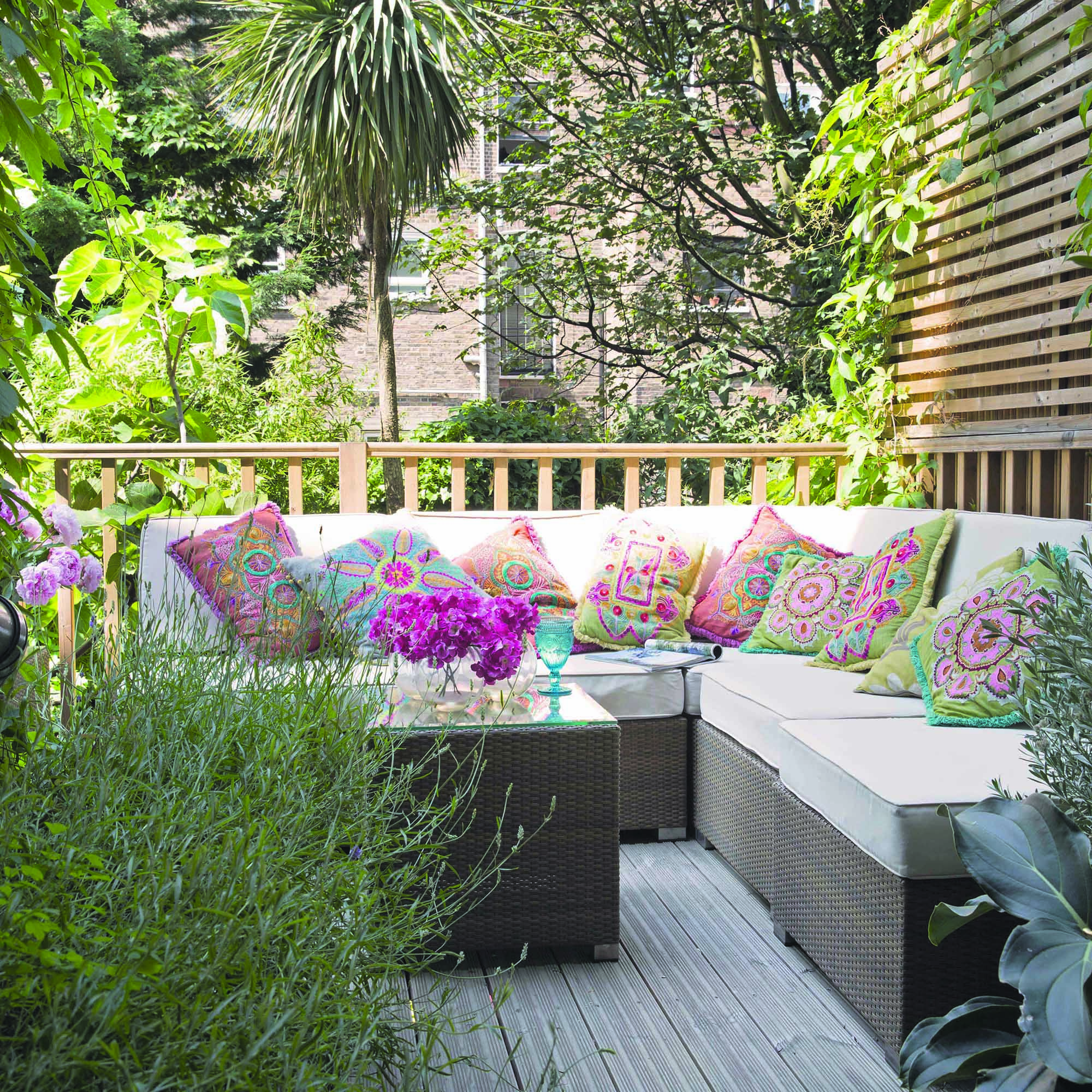
Just like you would in your living room, layer up your benches and armchairs will plenty of cushions for the ultimate spot for sundowners. A natural palette of neutrals and terracotta touches will work in almost any outdoor space, and will have a soothing, calming affect. Floor cushions are great for impromptu visiting friends and will add to the relaxed vibe.
'Give your garden seating an instant boost of comfort with some chic scatter cushions. A set of sumptuous outdoor scatter cushions will infuse any neutral garden furniture with a pop of personality and style, as well as comfort and softness. Better still, invest in some waterproof cushions for intense protection against fading, rain, spillages and stains,' Alex at Bridgman says.
12. Open up the space with a mirror
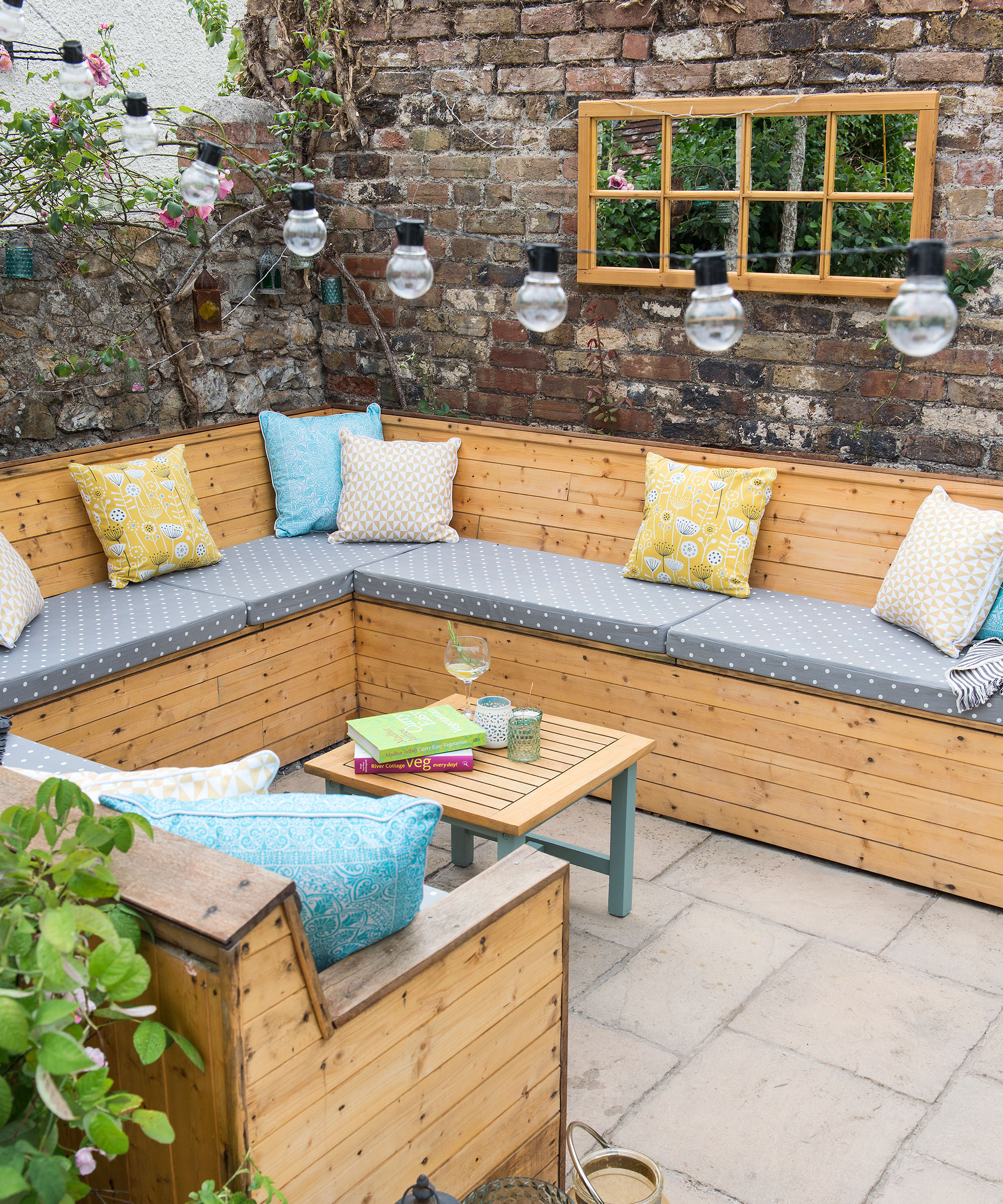
Mirrors are a great addition to any size garden, with the power to totally transform the space. Not only does it open up the space to make it seem bigger, it will reflect areas of garden that you might not be able to see from your seating spot, so allows you to enjoy more of it. Just like you would in your indoor living room, hang a mirror at a central point above your seating, or in the middle of a slim space.
13. Lay a rug over decking to add colour
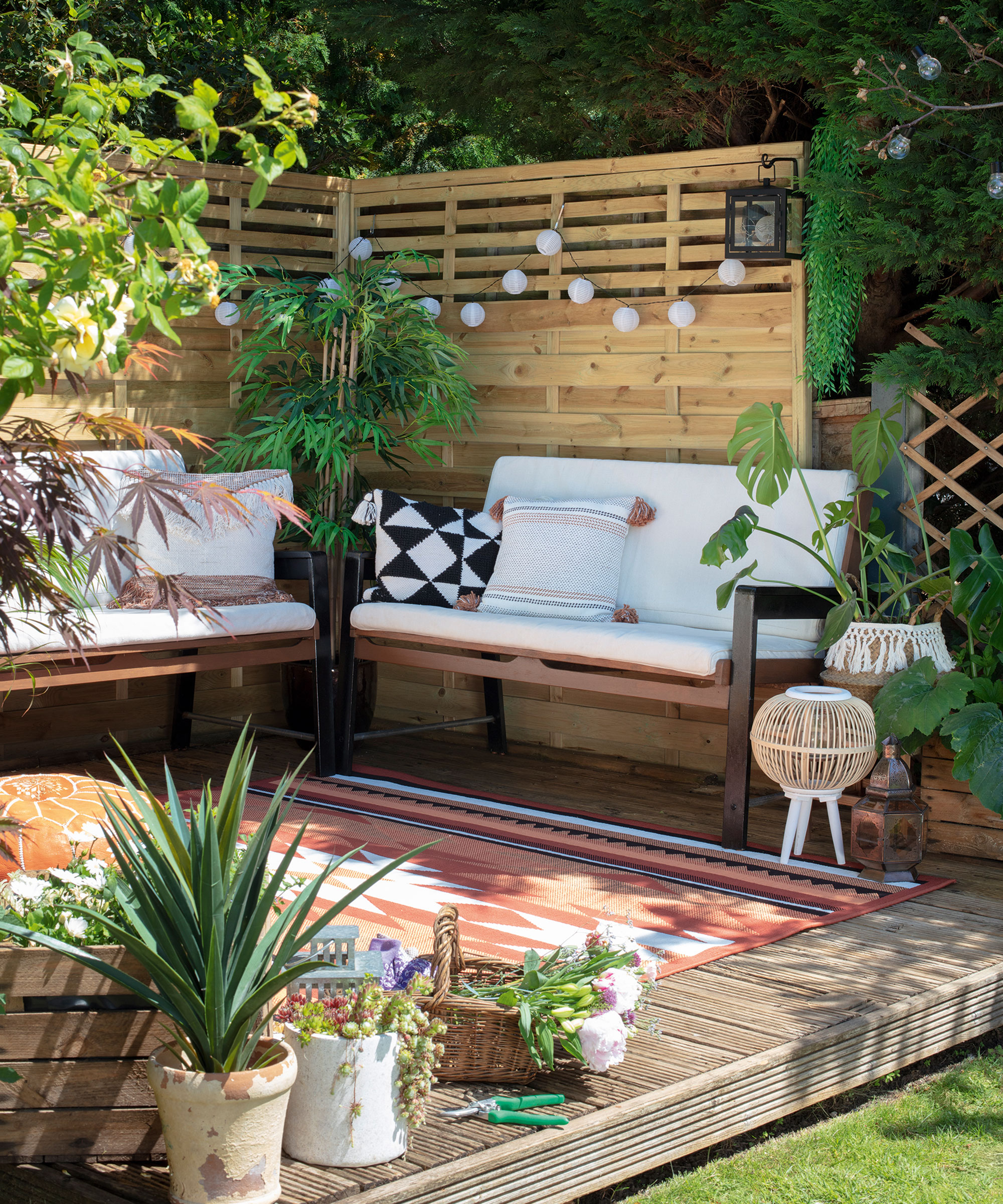
If our outdoor space is lacking slighting on colourful plants and flowers, a great way to introduce more, is with an outdoor rug. While a heavier blanket will work better on a lawn or grassed area, a rug is the perfect addition to a patio or decked space. Outdoor rugs are made with different fibres to their indoor counterparts, so they should with stand most weathers through-out the summer, but will need to be rolled up and stored over winter.
14. Combine a dining and living space
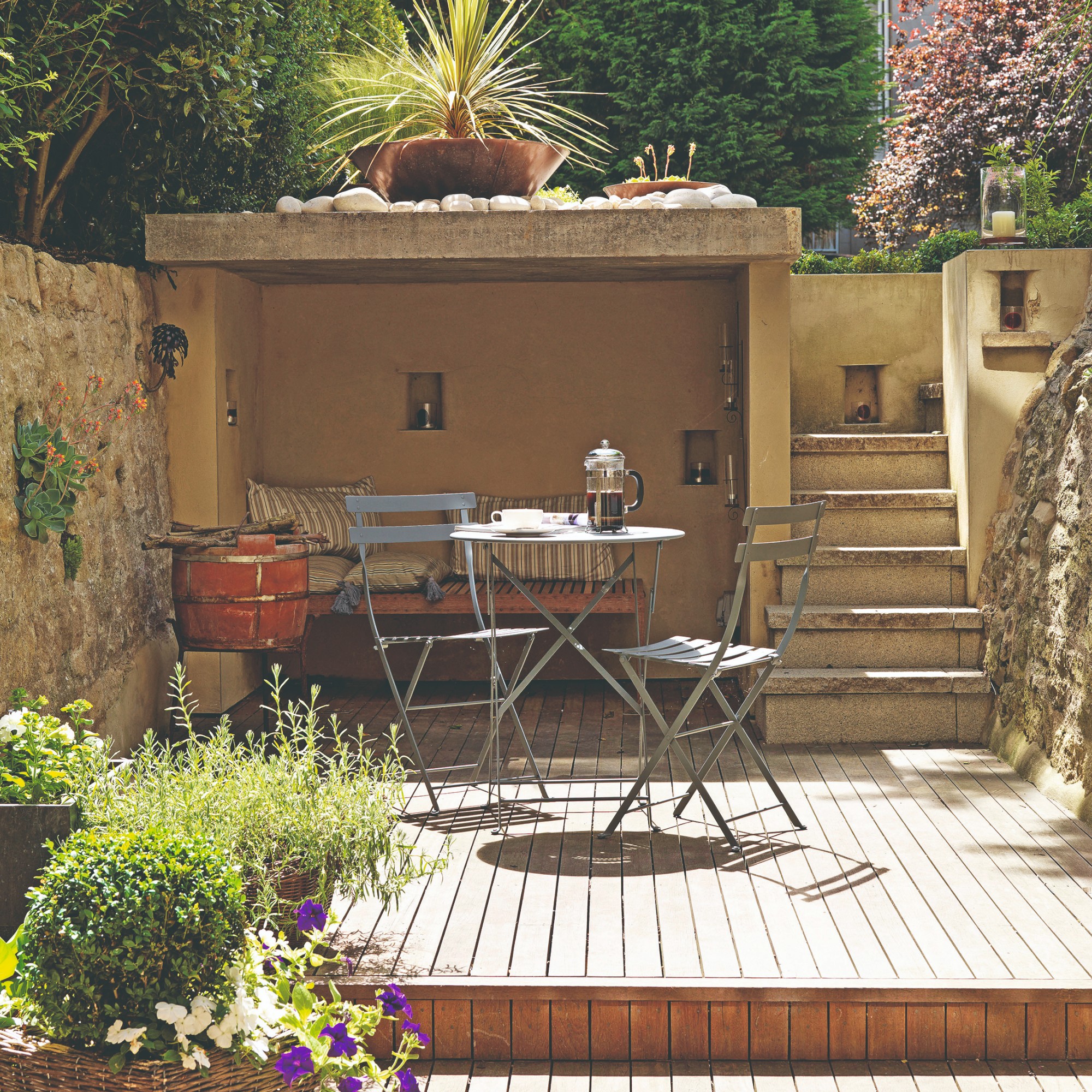
Let's face it, as soon as the sun makes an appearance, we want to spend as much time outside as possible, whether its at meal times, working in the shade or chilling with a good book. So create a space to combine all these things with an open-plan living and dining space. Bench seating is great for squeezing on several small bums, so ideal for family meal times. Armchairs and coffee tables will bring a reading nook vibe and layered rugs will keep toes cosy come sunset.
15. Utilise a parasol to keep things cosy

While a parasol will be great for blocking out direct sunlight during the day, it will also help to keep things cosy and intimate come the evening. It acts as a little 'roof' to your outdoor living space, keeping in the warmth of candles or patio heaters and will also act as protection should an evening shower hit. It's one of the most simple but effective outdoor living room ideas.
The best garden shade ideas will complement the rest of your outdoor decor as well as provide a much-needed retreat from the sun. Consider matching a parasol to your chosen colour scheme, or even opting for a micro-stripe to bring elements of the British seaside to your back garden.
16. Choose outdoor furniture that can be used inside too
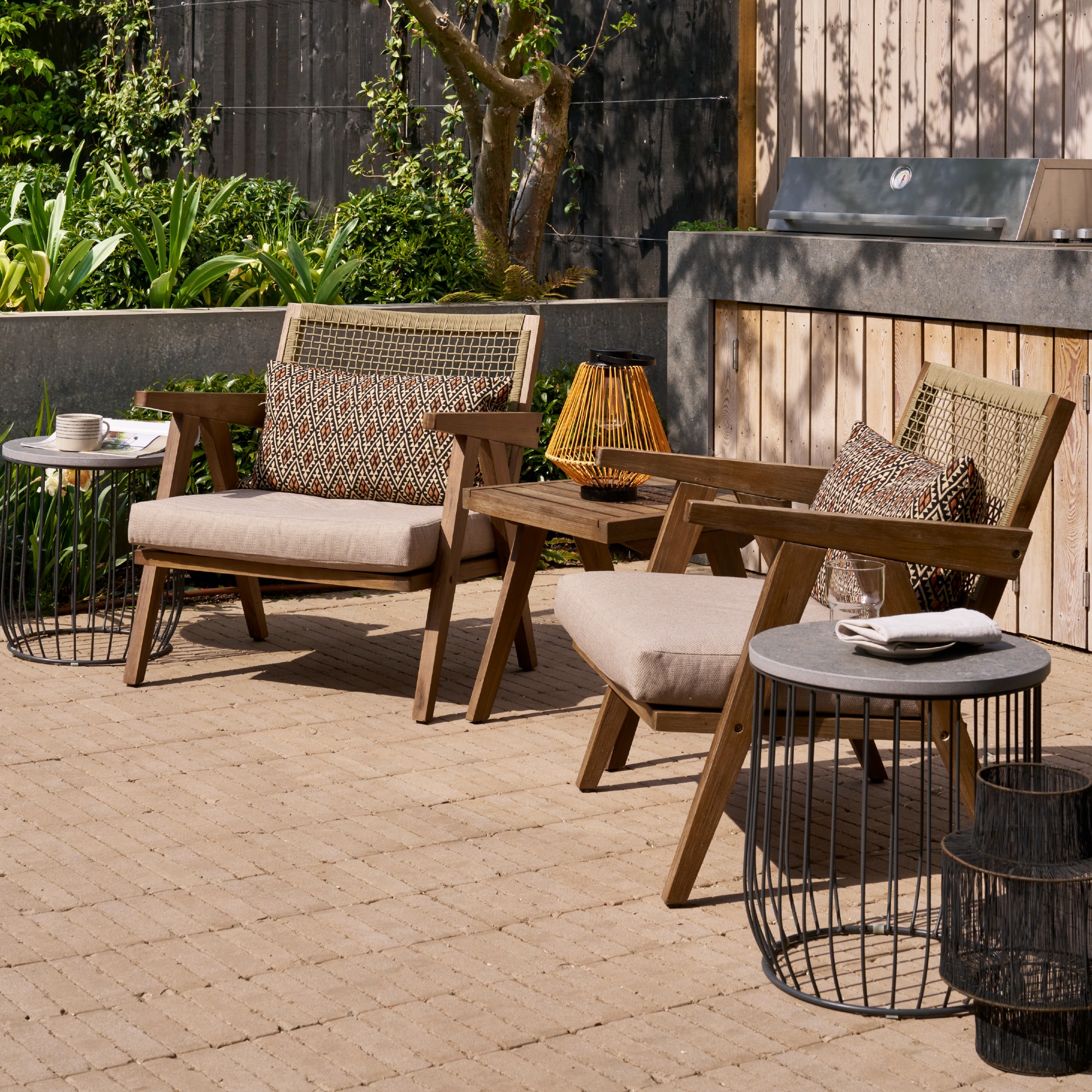
Just because outdoor furniture has the word 'outdoor' in it, doesn't mean you can't use it inside too! Mary Bunting, buyer at QVC says, 'Go for furniture that wouldn’t look out of place in a living room or a conservatory. Outdoor suitable materials are key as they are more durable and suitable to be left outdoors, but can also be used inside too.'
Rattan, cane and woven furniture are all popular choices for both inside and out and will work in both spaces through out the year.
17. Create a seamless flow
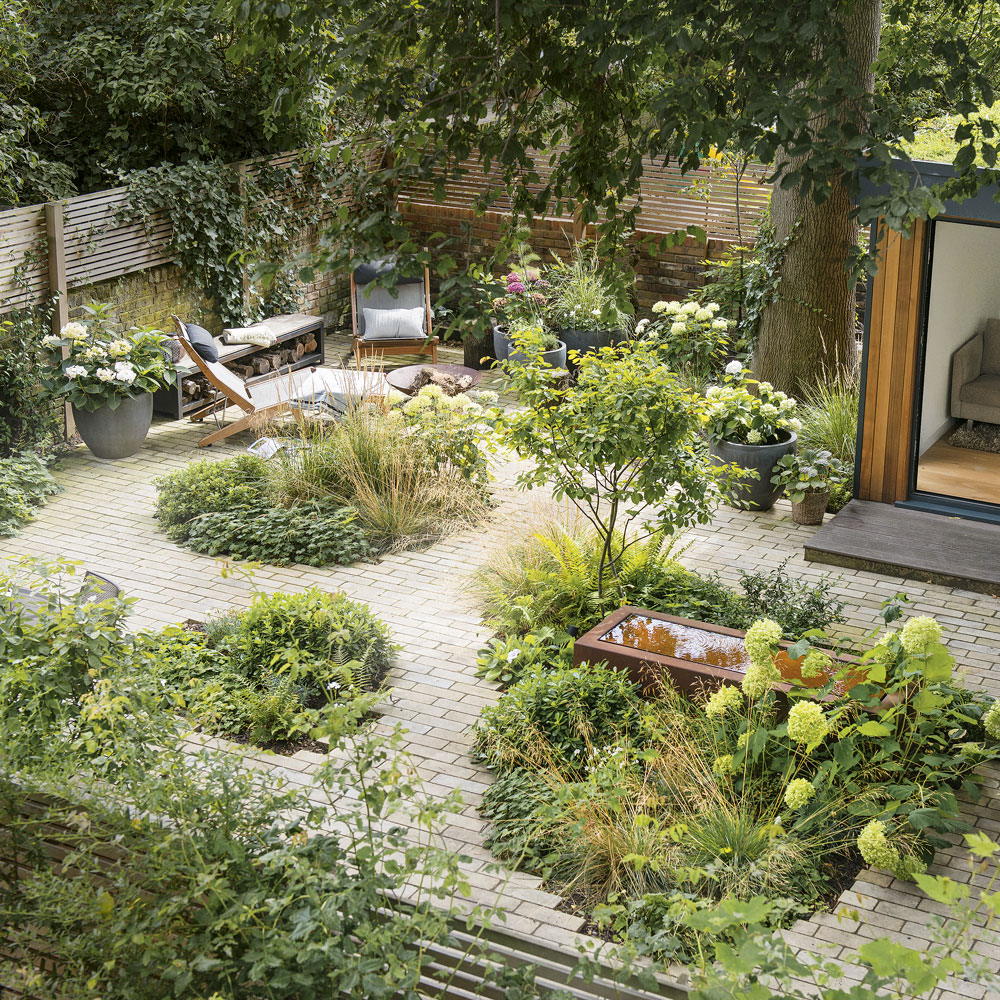
‘Connecting different links between spaces enhances the sense of rhythm and flow. Try using a limited palette of hard materials, or drifting key plants between different areas of planting,’ says Tom Massey, director of Tom Massey Studio.
Stylist Selina Lake adds: 'I’m not sure they always need to connect visually – you could decide on a different planting scheme for each zone – think scented herbs for somewhere to sit and relax, wild grasses and wildflowers for a charming dining space, or a Scandi-style seating area with all-white flowers.’
18. Extend the interior decor
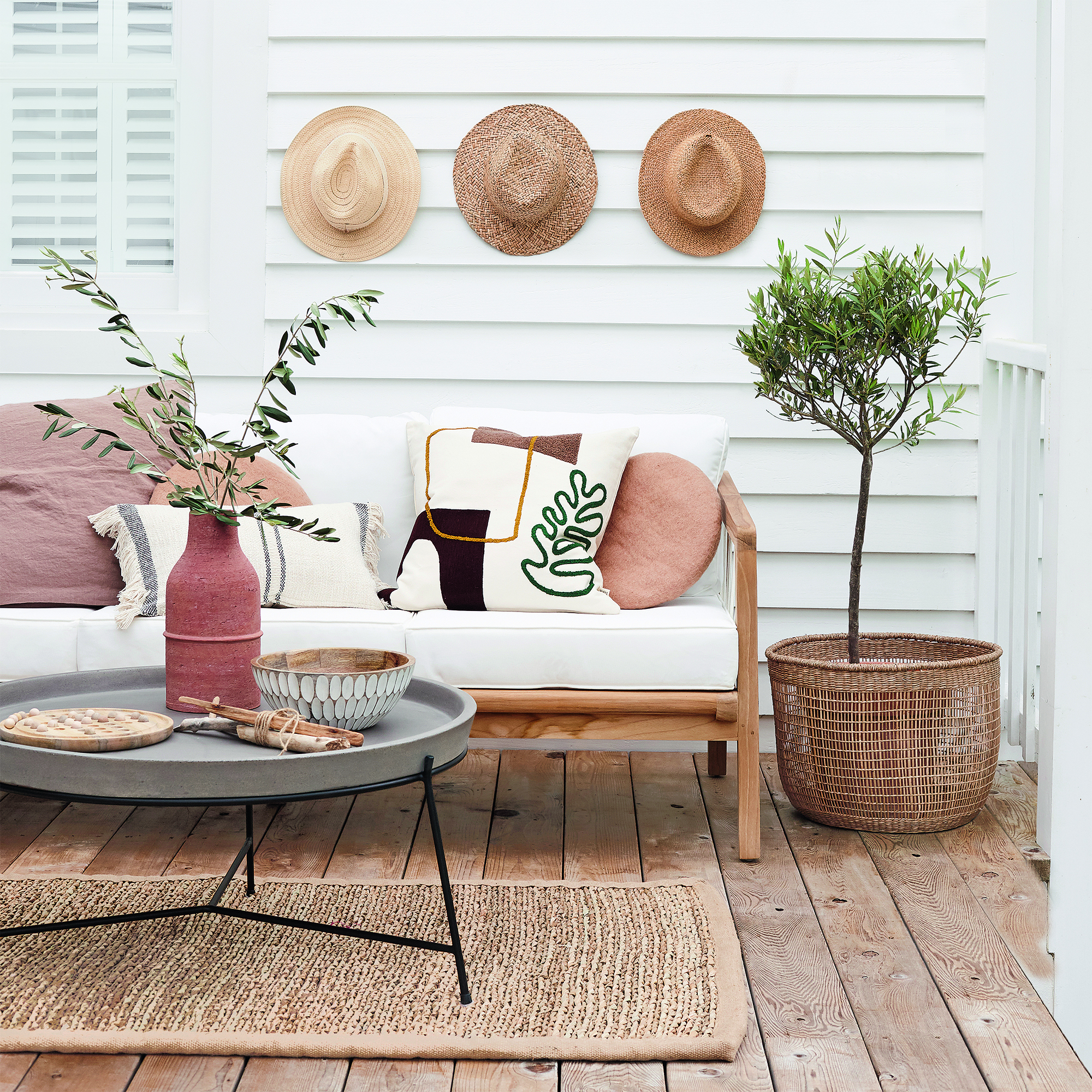
Extend your indoor space by dressing your outdoor living area with thoughtful furniture choices and accessories – such as armchairs and cushions. Woven rugs, like the jute rugs pictured above, are a great decor option for grassless garden ideas.
19. Define with edges and boundaries
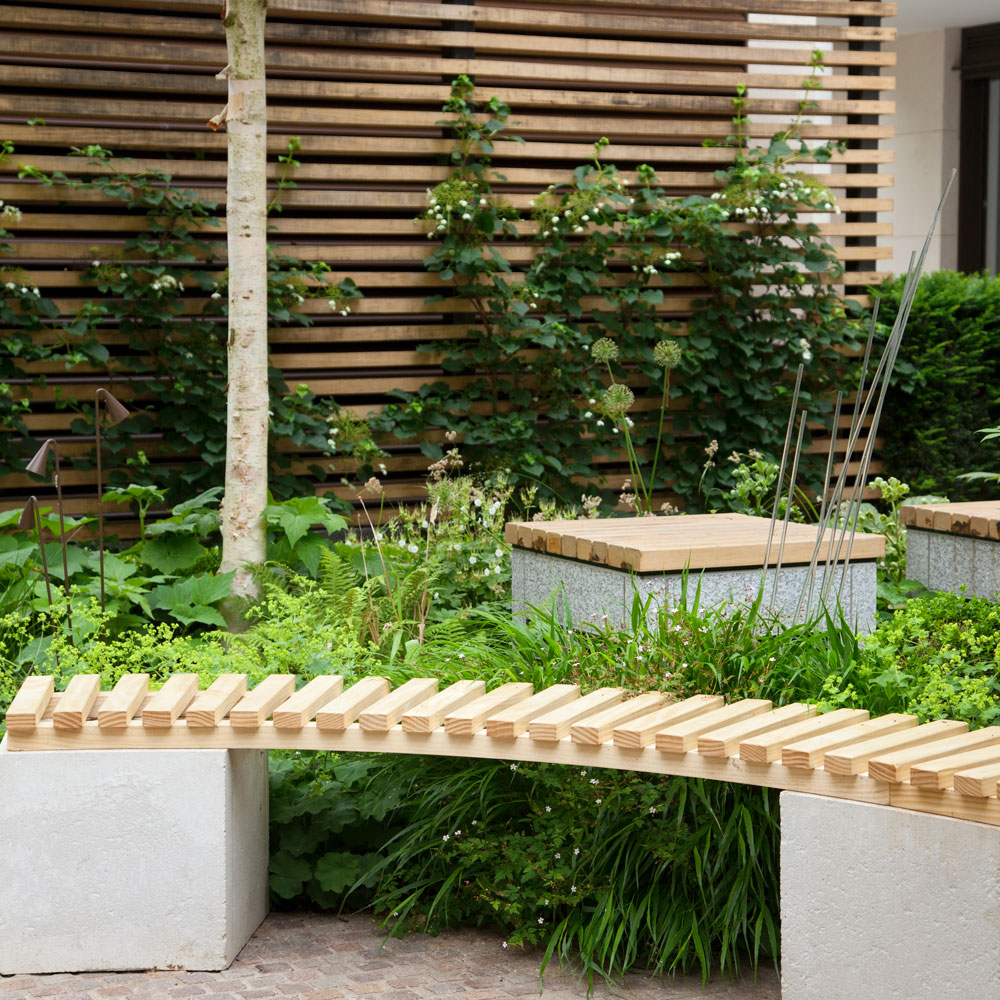
‘A mixed boundary with some planting, some screening and perhaps some features like integrated sculptural elements can add interest,’ says Tom. 'Boundaries can end up costing a lot of money, especially in larger gardens where the linear meter rates stack up.’
20. Illuminate with an outdoor lighting scheme
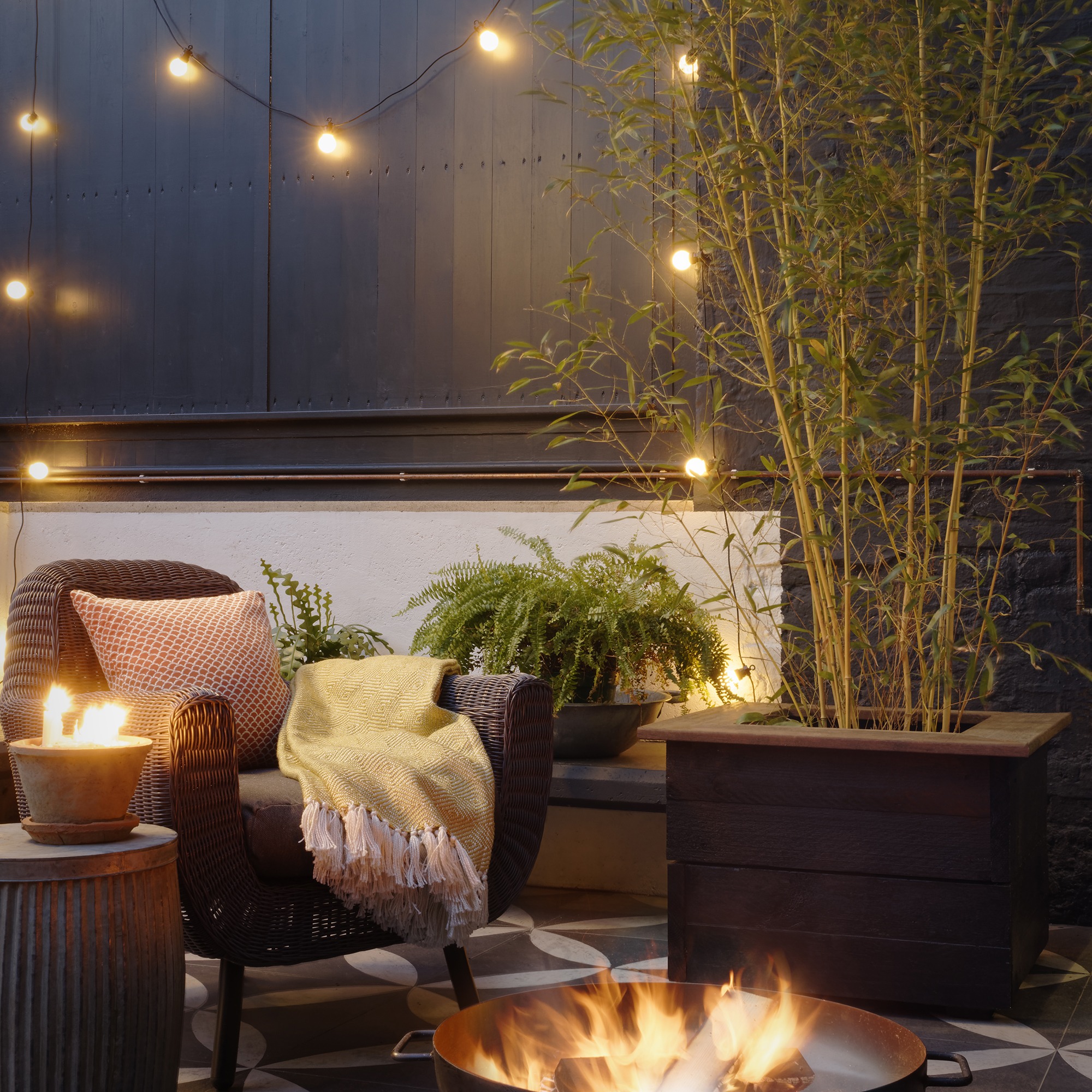
‘Festoon lights can be left out all-year-round and provide an easy and inexpensive way of adding magic to any outdoor space, while solar stake lights or path markers are a great solution of lighting your garden without plugs or wires,’ Tom adds.
‘The most simple and effective thing to do is to uplight trees – this looks dramatic and gives an ambient level of light. Too much lighting though and your garden can feel tacky and overblown.’
21. Add shade to make the space more versatile
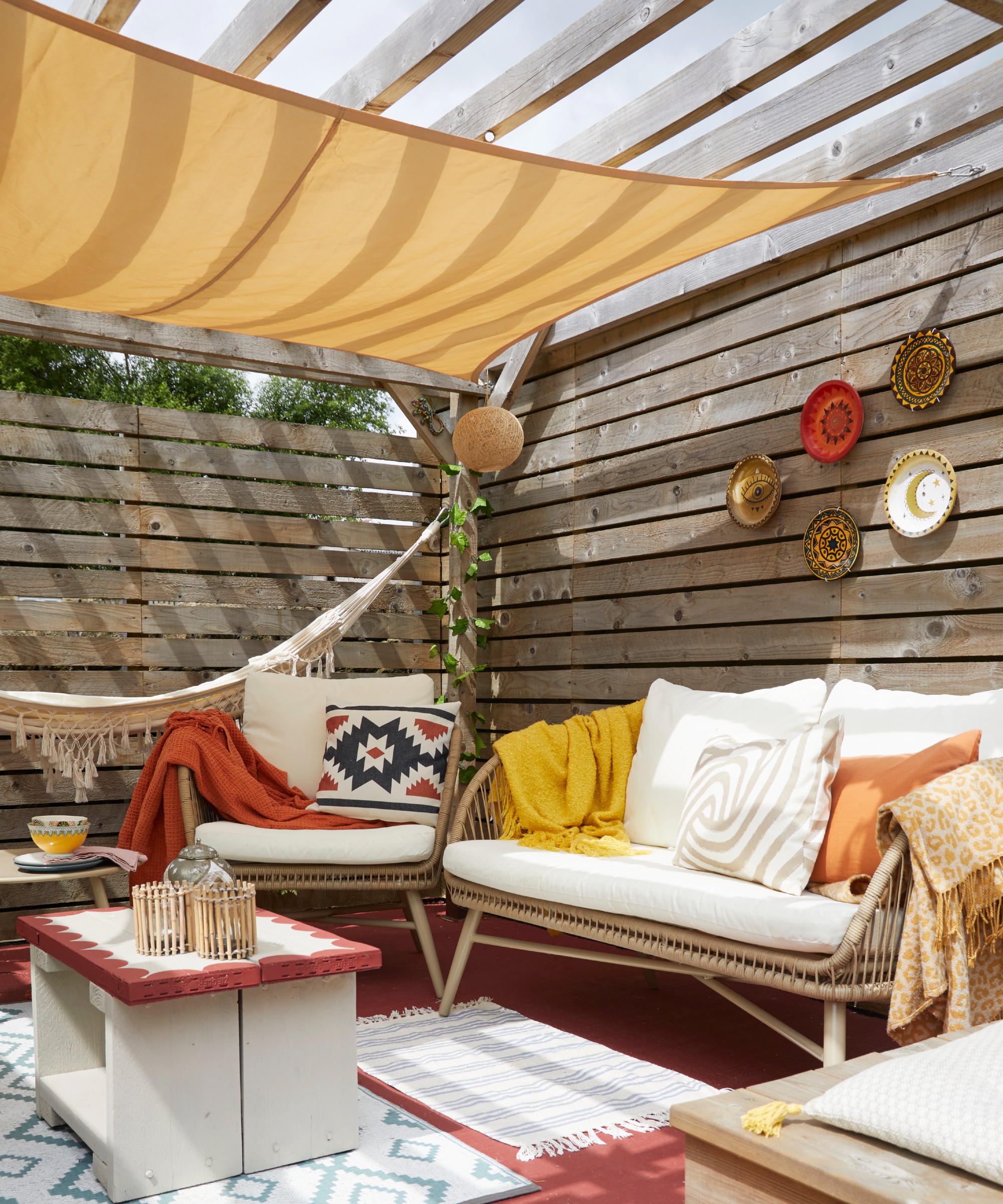
Get more from your outdoor living room by incorporating an element of garden shade, such as awnings and pergolas. Being able to shade the space during the hottest parts of the day will mean the area is available to use throughout all hours of the day.
‘Always ask “do I need it”,’ advises Tom. ‘In a shady garden, one will just add more shade, but on a sunny terrace, a pergola can make it useable in hot weather. It’s not always nice to sit in direct hot sun’.
22. Use paint with purpose
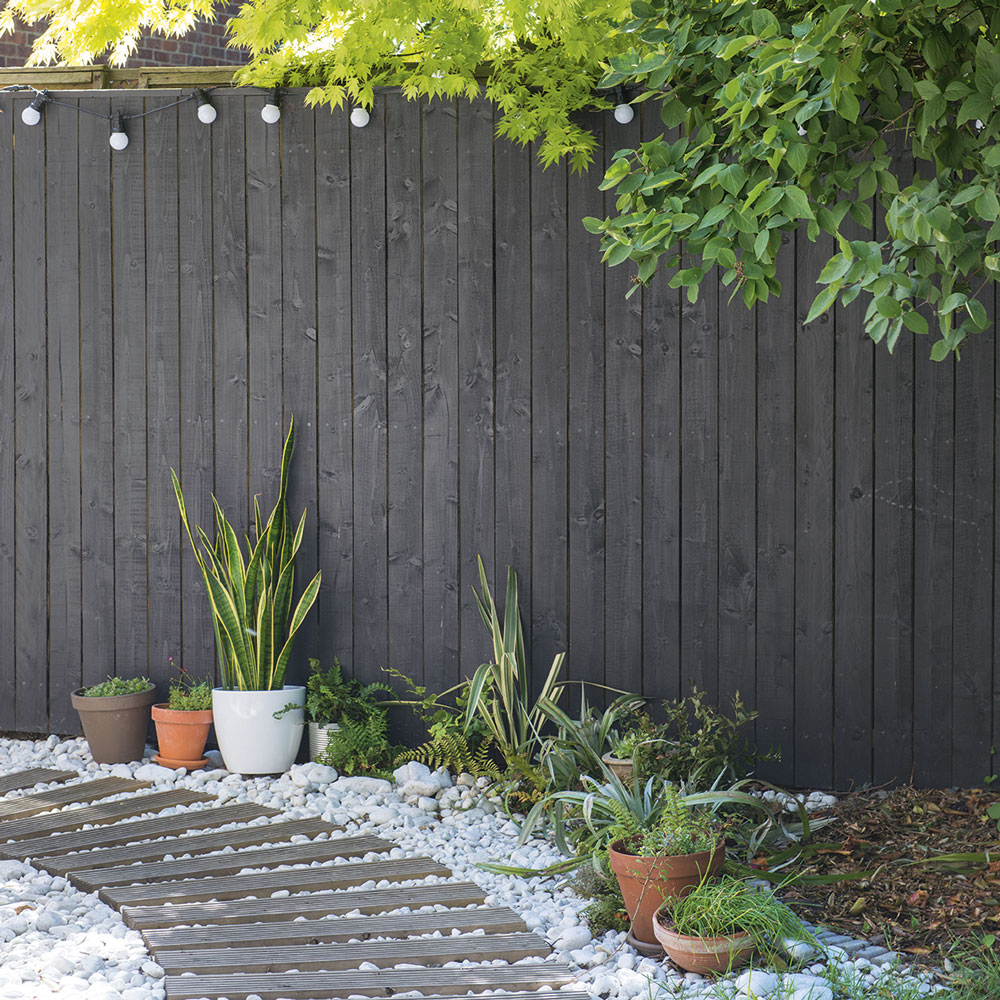
‘If you have an existing fence, painting it black makes it recede and can make the space feel bigger,’ says Tom. ‘Planting is also offset by the dark backdrop. Painting is cheap and can make a big difference, but remember if you paint it once, you will need to paint it again and will result in ongoing maintenance.’
‘Exterior paints and wood stains are great for revamping tired furniture – try painting black for a Scandi feel' advises Selina. 'For walls, a newly-built wall painted white is a great way of reflecting light, but I’d never paint an old, weathered wall – that would be a shame.’
23. Create a sense of calm with a water feature
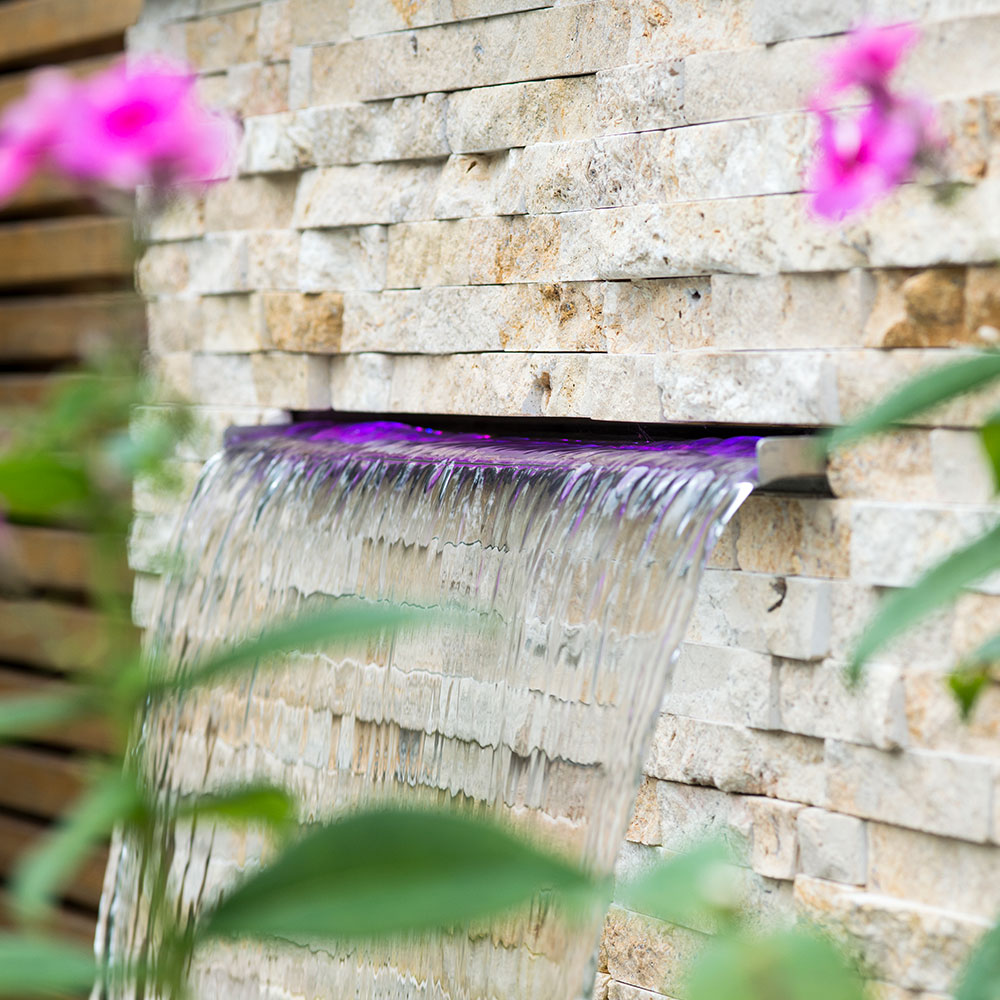
‘The sound of running water is so relaxing. Look for one that is just “plug and play” without any complicated set-up needed, or even an outdoor tap,’ says Dani Taylor, creative director at Cox & Cox.
24. Add a fire pit to make the space suitable for all seasons
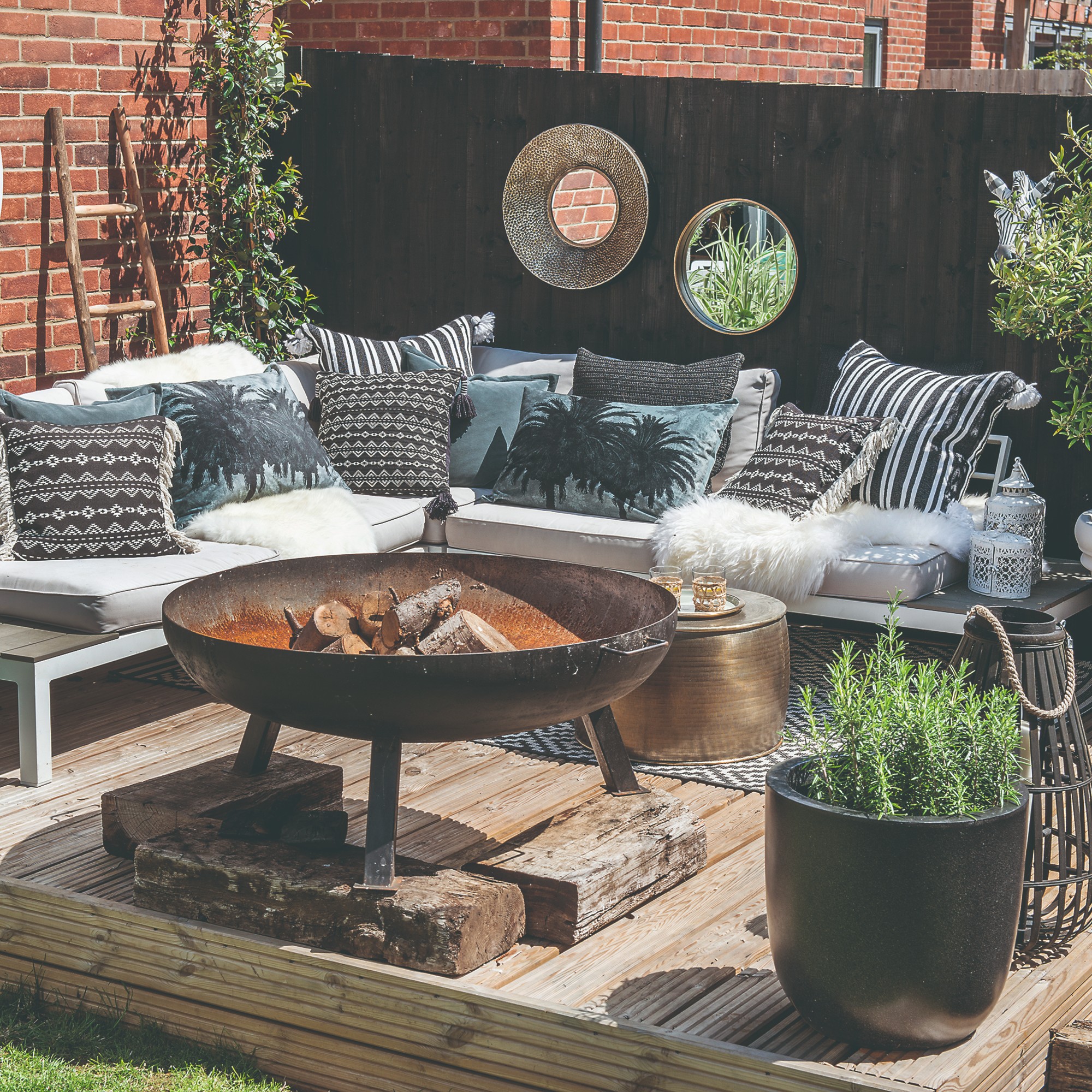
Whether you choose to build a permanent solution or buy a moveable design a fire pit makes an outdoor living room more versatile. No matter how chilly the evenings get, sitting around a warming fire makes the space more useable throughout the entire year. ‘A fire pit is great to sit around with the family, toasting marshmallows or cooking sausages, and is the perfect excuse to get everyone outside,’ says Dani at Cox & Cox.
King Living's 1977 design is one of the best outdoor sofas we've tried. It's super comfy, modular and equipped with a rust-resistant aluminium frame.
There are so many cool and sculptural side table designs you can adorn your outdoor living room with, while also making it more practical. And this La Redoute totem side table is the perfect example.
A few scatter cushions can instantly make an outdoor lounge make cosier and more stylish, especially an on-trend striped design like this one from John Lewis.
Your outdoor living room furniture can also help to brighten up your outdoor space, much like this sunny yellow coffee table will do. And it helps that yellow is one of the biggest garden furniture colour trends of 2025.
The beauty of this sophisticated John Lewis outdoor seating design is that it can be used as either one section of a larger modular sofa or just a garden chair, a very stylish one at that.
Parasols are the most stylish garden must-have this year. And it helps that they are both functional and chic, especially when they look like this striped, fringe-trimmed Habitat design.
FAQs
What is garden zoning and why is it a good idea?
‘Zoning is a design trick used inside and out,’ says stylist Selina Lake. ‘It basically divides up a space into different areas, e.g. in a garden you’d have somewhere to dine, relax, entertain or sunbathe. Zones work particularly well for families as you can create a hang-out area for teenagers, a stylish sofa space for coffee mornings and a family table that’s perfect for al fresco dining and bringing everyone together.’
Tom Massey, director of Tom Massey Studio, continues, ‘All too often I see gardens that have a large-paved terrace outside the house, a huge lawn and tiny borders with a few drab shrubs. This doesn’t offer any mystery or excitement – there’s no reason to explore as the whole space is revealed immediately. Zoning and screening can provide intrigue and destinations to draw you out into the space.’
‘You can use festoon poles and lights or even solar path lighters in planters to create pathways,' advises Dani Taylor, creative director at Cox & Cox, for defining the space.
What furniture materials are best for outdoor living rooms?
‘If you are looking for wood, then acacia is a good-wearing option,’ says Dani Taylor at Cox & Cox. ‘It’s used in ship building. For a metal option, choose aluminium as it’s light, lasts a long time and doesn’t rust. Most cushions are waterproof – or showerproof – but you should try to bring them in over the wetter months and cover the frames of your furniture with a breathable outdoor furniture cover.’
‘If you want low maintenance, thinking about how materials weather well is important. Choose timber that will fade naturally to a nice silver or corten steel that rusts to a deep dark brown,’ says Tom Massey.
What interior design tips can I use outside too?
‘I love to see jugs, vases and buckets filled with freshly-cut flowers,’ says Selina Lake. ‘They will instantly jolly up a space.’ Dani suggests a statement piece of furniture, ‘like a hanging chair positioned at the bottom of your garden to give you something to draw the eye. Or an outdoor mirror on a wall to give the illusion of more space. And if you need occasional extra seating, then use a daybed just as you would a bench inside.’
‘Your garden should be an extension of your home and style. Don’t compromise on garden furniture or accessories that you would never have inside,’ says Dani Taylor at Cox & Cox. ‘All-in-one solutions are really exciting, like a corner set with a built-in fire pit. They provide a real luxe feel to your garden and are super practical as you can lounge and dine.’
Now you can go and create your perfect outdoor living room of dreams that you’ll love spending time in every evening and weekend of the summer season.







